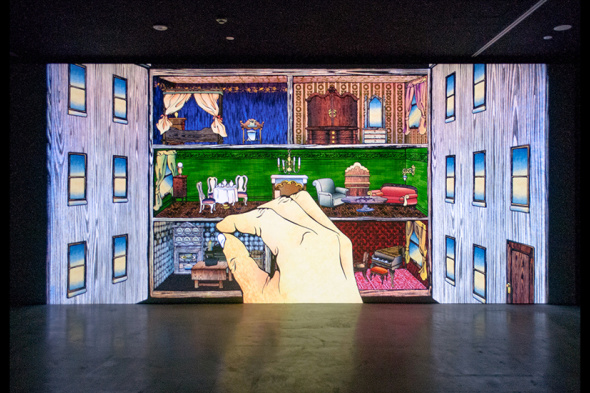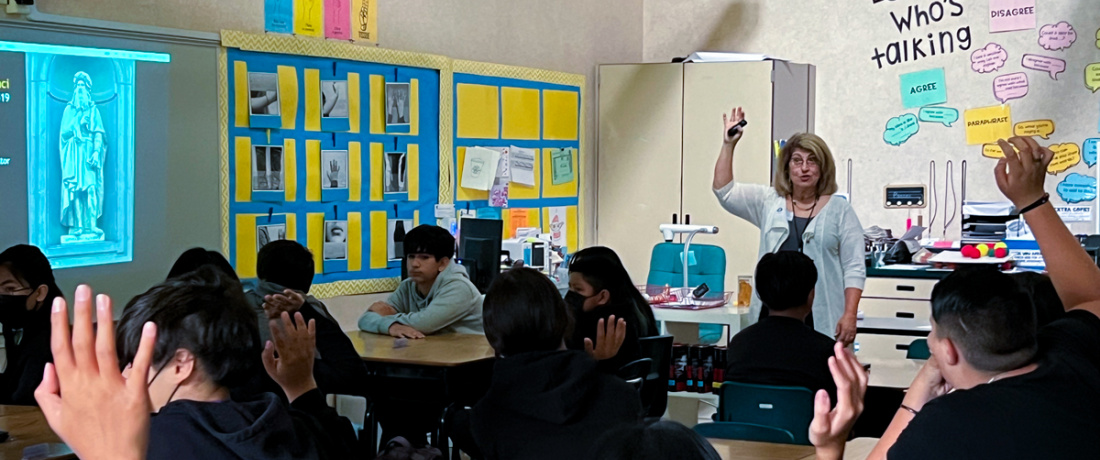Arts (Visual and Applied)

- Exhibition Spotlight: Tending and Dreaming: Stories from the Collection
- Digital Visual Communication
- Social Documentary and Street Photography
- Discovering Art Through Critical Thinking
- Diego Rivera and Frida Kahlo
- Mexican Art and Activism
- Resident Alien: Hung Liu
Image: Tabaimo, dolefullhouse, 2007.
Languages

- Diego Rivera and Frida Kahlo
- Mexican Art and Activism
- Discovering Art Through Critical Thinking
- Resident Alien: Hung Liu
Image: Enrique Chagoya, Thesis/Antithesis, 1998.
History

- Social Documentary and Street Photography
- Civil Rights in America
- Mexican Art and Activism
Image: National Child Labor Committee and Lewis Hine.
Arts
Exhibition Spotlight: Tending and Dreaming: Stories from the Collection
Grade 9-12, Arts – All levels, Language – All levels
Students use critical thinking skills as they perform an in-depth analysis and interpretation of artworks in the San José Museum of Art’s first dedicated collection galleries of pieces from the permanent collection. Highlighting artists as storytellers, students will uncover the many diverse voices and themes woven throughout the featured works including paintings, sculpture, and photography.
Digital Visual Communication
Grade 9–12, Computer Graphics, Yearbook, Multimedia
Students explore computer based graphic and information design, advertising, web design, cinematography, and data visualization in the context of effective visual communication. They discuss and analyze how the selection of the content, the elements of art, and the principles of design affect modern communication.
For a more in-depth program, a two-part presentation option is available. The topics covered in each part will be selected based on your curriculum.
Social Documentary and Street Photography: Keeping It Real
Grade 9–12, Photography, 2-D Art - All levels
Students explore the diverse and rich work of photographers who use their cameras as tools for social change. The presentation weaves together social documentary and street photographs to inspire students’ creativity.
For a more in-depth program, a two-part Photography presentation option is available:
- Part I – The Language of Photography: The Elements of Art through the Lens of Photography
- Part II – Social Documentary and Street Photography: Keeping It Real
Discovering Art Through Critical Thinking
Grade 9–12, 2-D Art, 3-D Art - All levels
Students use critical thinking skills to perform an in-depth analysis of form and content on a small number of contemporary artworks. They compare and contrast themes and the use of the elements of art, style, and varying media. Students interpret an artwork’s meaning and identify cultural and global significance while assessing how point of view and purpose shapes the content and style of the work(s).
Diego Rivera and Frida Kahlo: Defining Mexican Identity
Grade 9–12, 2-D Art - All levels
Students view Rivera’s murals and paintings and Kahlo’s self-portraits and other paintings, learning how their lives intertwined and how their styles differ. The connection among modern Mexico, the United States, and Russia is also discussed through the artworks of the two artists. Students look for the influences of cultural ideals and inventions on art.
Mexican Art and Activism: The Legacy
Grade 9–12, 2-D Art - All levels
Explore the artistic legacy of post-revolutionary Mexico and learn how it inspired artists across the border and around the world, including WPA muralists, Chicano artists, and contemporary street artists.
Resident Alien: Hung Liu
Grade 9–12, 2-D Art - All levels, Language - Mandarin, 3, 4 and AP
Students use critical thinking skills as they perform an in-depth analysis of form and content in Hung Liu’s art, focusing on self, society, politics, and challenges of reconciling differing cultures. Drawn to photographs, Liu paints from her own, those of historical Chinese, and Dorothea Lange’s images. She blends her individual story with larger themes of history, as she rescues the dignity of the dispossessed both in China and the United States. Chinese symbolism inspires interpretation as students analyze the meaning of her artworks.
Request an Art in the Dark Presentation
Languages
Diego Rivera and Frida Kahlo: Defining Mexican Identity
Grade 9–12, Spanish - All levels
Students view Rivera’s murals and paintings and Kahlo’s self-portraits and other paintings, learning how their lives intertwined and how their styles differ. The connection among modern Mexico, the United States, and Russia is also discussed through the artworks of the two artists. Students look for the influences of cultural ideals and inventions on art.
Discovering Art Through Critical Thinking
Grade 9–12, English, Journalism - All levels
Students use critical thinking skills to perform an in-depth analysis of form and content in a small number of contemporary artworks. They compare and contrast themes as well as the use of the elements of art, style, and varying media. Students interpret an artwork’s meaning and identify cultural and global significance while assessing how point of view and purpose shapes the content and style of the work(s).
Mexican Art and Activism: The Legacy
Grade 9–12, Spanish - All levels
Explore the artistic legacy of post-revolutionary Mexico and learn how it inspired artists across the border and around the world, including WPA muralists, Chicano artists, and contemporary street artists.
Resident Alien: Hung Liu
Grade 9–12, 2-D Art - All levels, Language - Mandarin, 3, 4 and AP
Students use critical thinking skills as they perform an in-depth analysis of form and content in Hung Liu’s art, focusing on self, society, politics, and challenges of reconciling differing cultures. Drawn to photographs, Liu paints from her own, those of historical Chinese, and Dorothea Lange’s images. She blends her individual story with larger themes of history, as she rescues the dignity of the dispossessed both in China and the United States. Chinese symbolism inspires interpretation as students analyze the meaning of her artworks.
Request an Art in the Dark Presentation
History
Social Documentary and Street Photography: Keeping It Real
Grade 11
Students explore the diverse and rich work of photographers who use their cameras as tools for social change. The presentation weaves together social documentary and street photographs to inspire student’s creativity.
For a more in-depth look at American culture and forms of activism we recommend you request both the Civil Rights in America and the Social Documentary and Street Photography presentations.
Civil Rights in America: American Artists and the Struggle for Equality
Grade 11
Students explore social justice and American Ideals as they interpret art by American artists from the pre-civil rights era to the present. Topics include: the Civil Rights Movement during the 1950s and 1960s, the Chicano Movement of the 1960s, the Civil Rights of Japanese Americans and how contemporary artists represent these issues today.
Please note that content will vary depending on the presentation time, so please let your docent know your preferences.
Mexican Art and Activism: The Legacy
Grade 10, 11
Explore the artistic legacy of post-revolutionary Mexico and learn how it inspired artists across the border and around the world, including WPA muralists, Chicano artists, and contemporary street artists.
Request an Art in the Dark Presentation
Special Days Classes
Art for you SDC
Grade 9–12, SDC
Students participate in a fun, informative, and interactive look at the way we communicate through art using the elements of art. The presentation adapts to fit wide-ranging needs and capabilities of the special education student. Your docent will work with you to provide the drawing activity, video and artwork selections, and mode of delivery that will best meet the needs of your students.
For a more in-depth program, a two-part presentation option is available. The topics covered in each part will be selected based on your curriculum.

